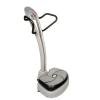 Whole-body vibration (WBV) is a treatment where a patient stands on a platform that oscillates at a particular frequency and amplitude, causing muscle contractions through stimulation of sensory receptors.
Whole-body vibration (WBV) is a treatment where a patient stands on a platform that oscillates at a particular frequency and amplitude, causing muscle contractions through stimulation of sensory receptors.
These devices are available over the Internet and generally viewed as a fad.
Researchers at the University of Extremadura, in Caceres, Spain, studied the effects of WBV on dynamic balance (balance while moving) in women with fibromyalgia.
First, the details.
- 41 adult women were randomly assigned to a treatment group for 12 weeks.
- WBV consisted of 30 minutes of instruction plus 3 sessions of 6 repetitions of a 45- to 60-second 12.5-Hz vibration.
- Control group
- Dynamic balance was assessed using a balance platform — a device that measures neutral balance.
And, the results.
- Among the women who completed the study, dynamic balance with WBV improved 36% compared to the start of the study.
- Dynamic balance didn’t change in the control group.
- WBV was associated with significantly greater improvement in balance compared to the control group.
The bottom line?
The authors concluded, “The vibration program was useful and feasible for improving dynamic balance in women with fibromyalgia.”
In a Medscape interview, Dr. Stuart Silverman, a rheumatologist at Cedars-Sinai Medical Center in Los Angeles, California, acknowledged that these findings support the use of this device in patients with balance problems due to fibromyalgia. “Unanswered questions include the effect of WBV on muscle conditioning, endurance, and pain.”
There’s little formal research with this treatment. A couple of years ago, researchers in Germany compared WBV to physical therapy in patients with Parkinson’s disease. They reported, “Equilibrium and gait improved in patients with Parkinson’s disease receiving conventional WBV or conventional physical therapy in the setting of a comprehensive rehabilitation program.”
“There was no conclusive evidence for superior efficacy of WBV compared with conventional balance training.”
9/10/10 15:54 JR